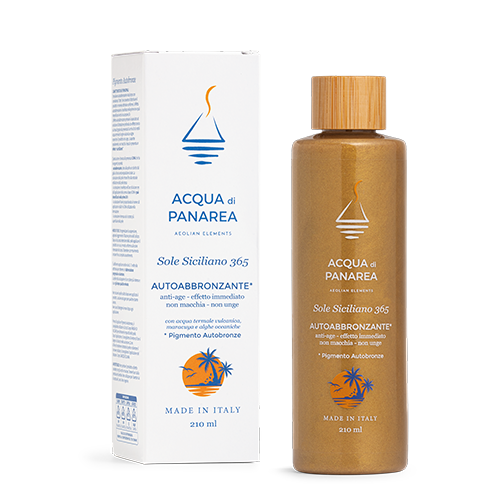We are sure that, at least once in your life, you must have wondered whether. self-tanning cream is bad for you. This is a point on which some false myths hover, and it is necessary to provide clarity so that you can understand that you are facing a safe product and that you can apply to your skin with confidence, as long as you make a quality choice.
It goes without saying that before choose self-tanning cream to apply to the skin you will have to do careful research, you will have to assess your skin type, figure out what your needs are, assess any allergies.
Although the result of applying a self-tanning product is not always perfect, it is good to remember that it cannot be harmful to your health.
How does a self-tanner work?
To answer all your doubts, the first question we are going to answer is about. how a self-tanner works. The first thing you need to know is that this type of product acts through a chemical reaction on the surface of the skin.
The most common active ingredient in self-tanners is the dihydroxyacetone (DHA), which we find in almost all products of this type and does no harm to the skin or the body.
Specifically, when applied to the skin, DHA reacts with amino acids found in the outermost layer of the skin, namely the stratum corneum. This reaction produces pigments called melanoidins, which are responsible for the tanned appearance you so enjoy.
After the application of your self-tanning product, the color develops gradually, reaching its maximum within a few hours. Remember that the intensity of the tan also depends on the DHA concentration you find in the product and by the chemistry of your skin.
Also the duration of the self-tanner can vary depending on the same factors, but usually a good self-tanner will not go away with a shower or stain your clothes. This is something you should always consider when you decide to use this type of product.
At this point, you are probably wondering if why after a few days the effect of the tanner tends to become increasingly bland. This happens because the skin is constantly renewed and this means that the dead cells Are replaced by new ones. Here, then, you will lose the DHA-treated cells and have to reapply the product if you do not want to have the faded tan effect.
To make make a self-tanner last longer we advise you to exfoliate the skin with a scrub before proceeding with the application. This way you can remove the dead cells and treat only the new ones.
See also the complete guide to the best self tanner.
The effects of a self-tanner
At this point, it is useful to understand what are the effects of a self-tanner On your skin. Answering this question is very important, because it allows you to understand that it is not a harmful product.
Without a doubt, themost obvious effect of a self-tanner is to Have a tan without sun exposure. If we have always said that the sunrays can cause damage to the skin and health in general, there is something to be said for self-tanning.
Be careful, however, not to forget the sunscreen (read our guide on the best facial sunscreen) which is always important, all year round, even in the city.
When applied properly, a self-tanner can provide a uniform color that can hide imperfections such as light scars, varicose veins and dyschromia. A real plus if you suffer from these blemishes and want to somehow camouflage them.
Beware, however, of spreading the product because, if you spread it inaccurately, it can give you a streaky tan that is certainly not pretty to look at and nobody likes.
Apply the product as directed on the package To get the best possible result. This way you can get that year-round tanned complexion that so many people love and that you are also looking for if you are here reading our tips.
When we talk about the effects of self-tanner, it is also important to remember that, in some cases, they also contain some Substances that provide moisture to the skin. The composition of the product, therefore, is very important because it tells you whether it will make your skin more beautiful, smooth and firm as well as sunless tan.
Are self-tanners bad for you?
As we told you, it has been talked about forever: self-tanners are bad for you? The answer is no, but we still want to argue the above, so that you can be aware of everything there is to know and, most importantly, how to choose a quality self tanner That is in line with your needs and the well-being of your skin.
After all, these products are mainly used for Achieve a tan without exposure to harmful ultraviolet rays (UV) of the sun, which are known to Increase premature aging and other damage skin conditions that can also be severe.
As mentioned earlier, the basic ingredient of self-tanners is the dihydroxyacetone (DHA), which is nothing more than a simple carbohydrate that reacts with amino acids in the outer layer of the skin and goes on to produce a pigment called melanoidine.
This reaction does not involve melanin, the skin's natural pigment that darkens in response to sun exposure, but produces a temporary color that mimics a natural tan.
The color develops within a few hours of product application and lasts until the treated epidermis cells are replaced by others. The process lasts about a week, which is also the shelf life of most self-tanners.
Also, you should know that the DHA concentration in self-tanning products is generally low and considered safe for topical use. No risk, therefore, to your skin.
Is a self-tanner bad for the face?
This, perhaps, is a great fear of yours. When we think about the facial skin we think of something fragile, which if treated with the wrong products can age prematurely.
He breathes a sigh of relief, however, because it will not happen because of a self-tanner. There are commercially available self-tanners for the face which are made precisely to give a tanned look to your skin, without the need for exposure to the sun. After all, it is the latter that ages your skin and from which you need to protect yourself thoroughly.
Of course, it is necessary that you always choose to use high-quality products and, above all, of apply them properly. This is a basic rule you should always follow when choosing a self-tanner, but not only.
If you are afraid that a self-tanner might make a reaction on your face, we recommend that you conduct a patch test On a small hidden area. This way you can check for any allergic reactions or irritation. We recommend that you do this especially if you are among those people with sensitive skin.
Always use some Self-tanning products formulated specifically for the face, which are generally lighter and less likely to cause pore clogging or skin imperfections.
Is a self-tanner bad for the body?
Another popular question is about the effects of theself-tanning body: hurts? The answer is no, but it is important to do some thinking. You will have to, again, pay attention to the product you select. This must be of high quality and must provide excellent performance, because otherwise the risk of irritation is around the corner, especially if you have sensitive skin.
We remind you that the Most common active ingredient in self-tanners is dihydroxyacetone, a substance reacts with dead skin cells and gives you a darker complexion, simulating a tan. DHA has been approved for topical use, making it safe for application to the skin on your body. However, it is always good to evaluate the quality of the product you choose, always aiming for high-quality ones.
Be careful: when applying self-tanning sprays, it is important to avoid inhaling the product. Inhaling DHA is not considered safe and could cause you respiratory problems.
We suggest, before you apply self-tanner, to perform a good exfoliation to remove dead skin cells, so as to achieve a more even application and reduce the risk of blemishes.
See also the guide to the self-tanners for legs.
Best self-tanners
Choosing the right self-tanner can be a challenge, especially since there are so many options on the market to evaluate that the choice could be difficult. However, always remember that a good self-tanner must provide a natural and uniform color, must be easy to apply e Must be safe for the skin.
If you wish to obtain a'beautiful and long-lasting tan, without exposing yourself to sunlight, evaluate these aspects and choose the best self-tanners.
Start from the ingredients, which are one of the first aspects to be evaluated. Products that contain moisturizing components such as aloe vera or natural oils can help to Nourish the skin while developing a tan.
These are ingredients known to maintain a soft and moisturized skin, counteracting the dehydrating effect that might characterize dihydroxyacetone (DHA).
Instead, carefully avoid self-tanners that include. alcohol or synthetic fragrances because they could dry out and irritate the skin. These components can also aggravate existing conditions or cause new problems such as Redness, itching or flaking.
Also, in choosing, assess your skin type. This is another deciding factor, if you have the sensitive skin prefer hypoallergenic formulas and specifically formulated for your type. Self-tanners that fall into this category tend to be gentler and less aggressive.
If, on the other hand, you have the oily skin, it is essential to opt for non-comedogenic products and formulated not to clog pores, thus preventing acne or other skin irritation that can result from using products that are too occlusive.
You will also need to evaluate the durability and color development. The speed with which the tan appears and its duration may vary, and it is good that, in this case, you also know your preferences in this regard.
Some self-tanners are beginning to show a color within a few hours, while others may require more time for a visible result. La duration of the tan, on the other hand, may depend on the formula of the product, but also on how well you prepare and maintain the skin.
Always exfoliate the skin before application e keep it hydrated in the following days: This can help prolong the effects of the self-tanner.
Also the ease of application Is a factor you need to evaluate. Whether you are an expert or a novice, evaluate only products that are easy to apply, because uneven application could result in a'patchy tan Unpleasant to look at.
We recommend that you choose a product such as. Sicilian Sun 365, an instant-effect anti-aging self-tanner that encompasses all the features we have mentioned.

This self-tanning emulsion for face and body is appreciated for its light texture, which gives you a great "fake" tanning experience. It is distinguished by its ability to give a Tanned complexion already in the first few hours after application, with an intensification of color that you can notice within the next 24 hours.
The formulation is enriched with a mix of noble oils and thermal water of volcanic origin, combined with the nourishing properties of ocean algae, creating a product that not only tans but also nourishes the skin.
This combination of ingredients ensures that the emulsion leaves no greasy residue and absorbs quickly without staining fabrics. It also provides a pleasant shimmering effect that further enhances your skin with a sophisticated glow effect.
The dihydroxyacetone (DHA) in the emulsion plays a very important role: the coloration appears gradually and develops most intensely in the first 24 hours.
The tone and color durability are proportional to the number of applications. This means you will be able to apply the product several times without getting an annoying layer-on-layer effect. Above all, you will be able to customize the end result.
Please note that DHA-induced tanning is limited to the most superficial layer of the skin, making it safe.
This type of self-tanning emulsion is ideal for those seeking a effective but gentle product, which offers natural and long-lasting color without compromising skin care.
Why choose a natural self-tanner
Opting for a natural self tanner is a conscious choice that reflects a growing focus on products that are safer and kinder to both skin and the environment.
These are products formulated with ingredients derived from natural sources, often organic, that offer both aesthetic and dermatological benefits without the 'use of aggressive chemicals found in some conventional self-tanners.
One of the main advantages of natural self-tanners resides in their composition Without synthetic preservatives, dyes and artificial fragrances, all substances that can Cause irritation, allergies or other skin problems.
Instead, ingredients such as essential oils, ocean algae extracts, plants and minerals nourish the skin and also support its natural barrier, promoting more even and long-lasting coloring.
By choosing products formulated with sustainable and biodegradable ingredients, you contribute to the reduction of environmental impact. This is especially important considering that many cosmetic products may contain components that end up polluting aquatic ecosystems.
Finally, theeffectiveness of a natural self-tanner is no less important. Even without the use of synthetic ingredients, these products can provide a natural, even tanned complexion, thus meeting the needs of those seeking safer, more respectful solutions without compromising quality or the desired effect.
The combination of safety, low environmental impact and effectiveness makes natural self-tanners an increasingly popular choice among modern consumers.
How to apply self-tanner
Applying a self-tanner is a process that requires care and attention, especially if your goal is to achieve uniform and natural results. The secret to a good application starts with the skin preparation.
Make sure the skin is Clean, exfoliated, and free of residual creams or oils. Exfoliation is very important because it removes dead skin cells, ensuring that the self-tanner adheres evenly.
Focus particularly on rough areas such as elbows, knees and ankles, where the skin tends to be drier. After exfoliation, remember to apply a moisturizer, especially in those areas.
This step helps you to Prevent excessive product accumulation in these areas, which could lead to a darker, unnatural tint. Pay attention, however, to the complete absorption of the cream before proceeding with the application of the self-tanner, because the effect might otherwise be patchy.
When applying self-tanner, uses circular motions To spread the product evenly over the skin. Start at the legs and work upward to avoid creases created by bending the body during application.
Many people recommend the use of a application glove To avoid staining your hands. If you don't use a glove, Wash hands with soap immediately after application to prevent the hands from becoming visibly darker than the rest of the body. Pay attention to detail and be sure to cover every part of the skin without neglecting areas such as the back, which may need the help of a second person or the use of a suitable application tool.




